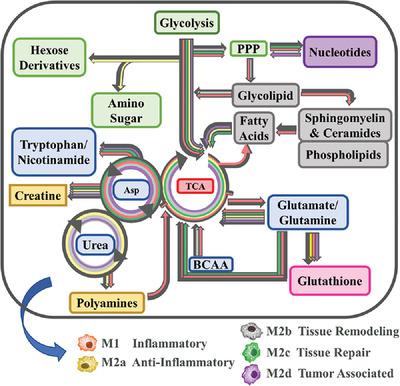当前位置:
X-MOL 学术
›
J. Leukoc. Biol.
›
论文详情
Our official English website, www.x-mol.net, welcomes your feedback! (Note: you will need to create a separate account there.)
Use of integrated metabolomics, transcriptomics, and signal protein profile to characterize the effector function and associated metabotype of polarized macrophage phenotypes
Journal of Leukocyte Biology ( IF 5.5 ) Pub Date : 2021-08-09 , DOI: 10.1002/jlb.6a1120-744r Catherine B Anders 1 , Tyler M W Lawton 1 , Hannah L Smith 1, 2 , Jamie Garret 1, 3 , Margaret M Doucette 4 , Mary Cloud B Ammons 1
Journal of Leukocyte Biology ( IF 5.5 ) Pub Date : 2021-08-09 , DOI: 10.1002/jlb.6a1120-744r Catherine B Anders 1 , Tyler M W Lawton 1 , Hannah L Smith 1, 2 , Jamie Garret 1, 3 , Margaret M Doucette 4 , Mary Cloud B Ammons 1
Affiliation

|
MΦs display remarkable plasticity and the ability to activate diverse responses to a host of intracellular and external stimuli. Despite extensive characterization of M1 MΦs and a broad set of M2 MΦs, comprehensive characterization of functional phenotype and associated metabotype driving this diverse MΦ activation remains. Herein, an ex vivo model was utilized to produce 6 MΦ functional phenotypes. Isolated CD14+ PBMCs were differentiated into resting M0 MΦs, and then polarized into M1 (IFN-γ/LPS), M2a (IL-4/IL-13), M2b (IC/LPS), M2c (IL-10), and M2d (IL-6/LIF) MΦs. The MΦs were profiled using a bioanalyte matrix of 4 cell surface markers, ∼50 secreted proteins, ∼800 expressed myeloid genes, and ∼450 identified metabolites relative to M0 MΦs. Signal protein and expressed gene profiles grouped the MΦs into inflammatory (M1 and M2b) and wound resolution (M2a, M2c, and M2d) phenotypes; however, each had a unique metabolic profile. While both M1 and M2b MΦs shared metabotype profiles consistent with an inflammatory signature; key differences were observed in the TCA cycle, FAO, and OXPHOS. Additionally, M2a, M2c, and M2d MΦs all profiled as tissue repair MΦs; however, metabotype differences were observed in multiple pathways including hexosamine, polyamine, and fatty acid metabolism. These metabolic and other key functional distinctions suggest phagocytic and proliferative functions for M2a MΦs, and angiogenesis and ECM assembly capabilities for M2b, M2c, and M2d MΦs. By integrating metabolomics into a systems analysis of MΦ phenotypes, we provide the most comprehensive map of MΦ diversity to date, along with the global metabolic shifts that correlate to MΦ functional plasticity in these phenotypes.
中文翻译:

使用综合代谢组学、转录组学和信号蛋白谱来表征极化巨噬细胞表型的效应子功能和相关代谢型
MΦs 显示出非凡的可塑性和激活对大量细胞内和外部刺激的不同反应的能力。尽管对 M1 MΦs 和广泛的 M2 MΦs 进行了广泛的表征,但驱动这种多样化 MΦ 激活的功能表型和相关代谢型的综合表征仍然存在。在此,利用离体模型产生 6 MΦ 功能表型。分离的 CD14 +PBMC 分化为静息 M0 MΦs,然后极化为 M1 (IFN-γ/LPS)、M2a (IL-4/IL-13)、M2b (IC/LPS)、M2c (IL-10) 和 M2d (IL -6/LIF) MΦs。使用 4 种细胞表面标记物、约 50 种分泌蛋白、约 800 种表达的骨髓基因和约 450 种与 M0 MΦ 相关的已鉴定代谢物的生物分析物矩阵对 MΦ 进行了分析。信号蛋白和表达的基因谱将 MΦs 分为炎症(M1 和 M2b)和伤口消退(M2a、M2c 和 M2d)表型;然而,每个都有独特的代谢特征。虽然 M1 和 M2b MΦs 共享与炎症特征一致的代谢型特征;在 TCA 循环、FAO 和 OXPHOS 中观察到关键差异。此外,M2a、M2c 和 M2d MΦs 都被描述为组织修复 MΦs;然而,在包括己糖胺、多胺、和脂肪酸代谢。这些代谢和其他关键功能差异表明 M2a MΦ 具有吞噬和增殖功能,而 M2b、M2c 和 M2d MΦ 具有血管生成和 ECM 组装能力。通过将代谢组学整合到 MΦ 表型的系统分析中,我们提供了迄今为止最全面的 MΦ 多样性图谱,以及与这些表型中的 MΦ 功能可塑性相关的全球代谢变化。
更新日期:2021-08-09
中文翻译:

使用综合代谢组学、转录组学和信号蛋白谱来表征极化巨噬细胞表型的效应子功能和相关代谢型
MΦs 显示出非凡的可塑性和激活对大量细胞内和外部刺激的不同反应的能力。尽管对 M1 MΦs 和广泛的 M2 MΦs 进行了广泛的表征,但驱动这种多样化 MΦ 激活的功能表型和相关代谢型的综合表征仍然存在。在此,利用离体模型产生 6 MΦ 功能表型。分离的 CD14 +PBMC 分化为静息 M0 MΦs,然后极化为 M1 (IFN-γ/LPS)、M2a (IL-4/IL-13)、M2b (IC/LPS)、M2c (IL-10) 和 M2d (IL -6/LIF) MΦs。使用 4 种细胞表面标记物、约 50 种分泌蛋白、约 800 种表达的骨髓基因和约 450 种与 M0 MΦ 相关的已鉴定代谢物的生物分析物矩阵对 MΦ 进行了分析。信号蛋白和表达的基因谱将 MΦs 分为炎症(M1 和 M2b)和伤口消退(M2a、M2c 和 M2d)表型;然而,每个都有独特的代谢特征。虽然 M1 和 M2b MΦs 共享与炎症特征一致的代谢型特征;在 TCA 循环、FAO 和 OXPHOS 中观察到关键差异。此外,M2a、M2c 和 M2d MΦs 都被描述为组织修复 MΦs;然而,在包括己糖胺、多胺、和脂肪酸代谢。这些代谢和其他关键功能差异表明 M2a MΦ 具有吞噬和增殖功能,而 M2b、M2c 和 M2d MΦ 具有血管生成和 ECM 组装能力。通过将代谢组学整合到 MΦ 表型的系统分析中,我们提供了迄今为止最全面的 MΦ 多样性图谱,以及与这些表型中的 MΦ 功能可塑性相关的全球代谢变化。


























 京公网安备 11010802027423号
京公网安备 11010802027423号